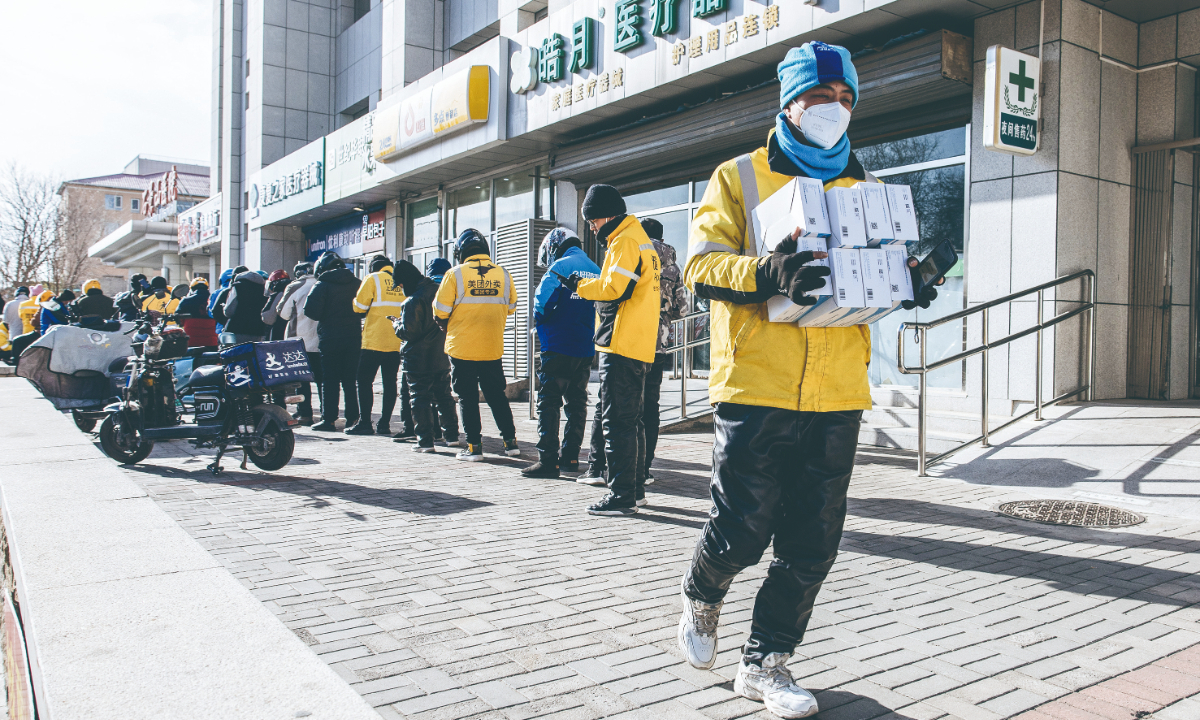Public access to medical care 'immediate priority' of COVID prevention; more focus given to rural areas: health officials

Delivery personnel dispatch COVID-19 antigen kits and medicines for fever, cold and cough as demand surges on December 8, 2022, after restrictions on drug purchases were lifted. Many pharmacies and drug producers are scrambling to ramp up supply in response. Photo: Li Hao/GT
The immediate priority of epidemic prevention and control in China is to ensure the public's access to medical care, while giving focus to strengthening the prevention work and health services in rural areas, a spokesperson of China's National Health Commission (NHC) said on Tuesday at a press conference held by the State Council Joint Prevention and Control Mechanism Against COVID-19.
Mi Feng, the spokesperson of the NHC, urged regions across the country to expand the supply of medical services on multiple platforms, increase the supply of relevant drugs, expand resources for the treatment of critically ill patients, and guard people's lives against serious illnesses.
At the same time, more focus should be put on the epidemic prevention work and health services in rural areas, specifically to identify the health situation of key populations, smooth "green channels" for treatment, and open fever clinics as much as possible in townships and strengthen drug prescription work and other services.
As some data centers in recent days were calculating the COVID-19 curves for each locality, a number of provinces issued notices on the prediction of infection peaks, most of which come around next January when the biggest festival for Chinese people - Spring Festival - falls.
South China's Guangdong Province and East China's Zhejiang, Shandong and Jiangxi provinces made the predictions based on the more frequent personnel flows and gatherings during the Spring Festival. They have vowed to strengthen medical resource reserves and enhance treatment capacity to cope with the upcoming peak of the epidemic.
In addition, urban areas are more densely populated than rural areas, thus the peak of infection will come relatively later than rural areas, the notices said.
Health experts urged at the Tuesday conference that people should not rush to get infected. Once a large-scale outbreak occurs, social order and people's livelihoods will be seriously affected, causing great pressure for or even overcrowding of medical institutions, which will then affect the normal emergency response and other critical care of patients.
They advised senior citizens, especially those who have not been vaccinated, to strengthen precautions against the wave of infection, as the virus spike could bring an uneven distribution of medical resources.
Currently, the first round of the epidemic is in a rapid growth phase. It will slow down after a while, but a new peak could come due to large-scale social activities including chunyun, the Spring Festival travel rush. Eventually, a herd immunity barrier will be formed and the prevalence of the disease will drop significantly, experts said.
Wu Zunyou, chief epidemiologist at the Chinese Center for Disease Control and Prevention (China CDC), predicted on Saturday that the epidemic this winter will have "one peak and three waves."
The first wave will last from mid-December to mid-January next year, mainly in urban populations. The second wave will be from late January to mid-February due to the movement of people during Spring Festival. The third wave will be from late February to mid-March when people return to work after the holiday. The entire process will last about three months, Wu said.
Also at the press conference, Xu Wenbo, head for National Institute for Viral Disease Control and Prevention with the China CDC, said a total of over 130 Omicron subvariants had entered China in the past three months.
The BQ.1 strain has been detected in 49 cases in nine provinces across China, and XBB was detected in 11 cases in three provinces. While they have not yet formed a dominant transmission chain in China, their spread will gradually increase.
"Coping measures for the BQ.1 and XBB mutants are the same as with other Omicron strains - monitoring their pathogenicity to see if there is any change in genomes. Currently, no reports of increased serious illness and death due to BQ.1 and XBB in China or abroad have been found," Xu said.
Global Times


